What If You’re Partially Responsible For Causing Your Own Accident?
If you’ve been injured in an accident and file a civil lawsuit, seeking damages, a judge or jury must first determine who caused the accident. The person whose negligence is determined to have caused the accident pays for the resulting damage.
If more than one person caused the damage, then negligence is distributed between the parties based on state apportionment laws. The fact-finder may determine that actions of the defendant, the plaintiff, or both, caused the accident. Based on the evidence submitted, the judge or jury will then allocate the amount or percentage that each party was negligent. In California, this allocation is based on a system of pure comparative negligence.
In a pure comparative negligence system, a judge or jury assigns a percentage of fault to each responsible party and then apportions the damage award accordingly, reducing the plaintiff’s recovery by his or her percentage of fault in causing the accident. Using this system, an injured person may recover his or her damages even if the injured person was 99% at fault in causing the injury, with those damages reduced by his or her portion of the fault.
For example, in a car accident between Joe and Jane where Jane was found to be 99% responsible, and the jury found that Jane suffered $10,000 in damages, that award would be reduced by Jane’s 99% fault in causing the injury. In the end, Joe would only have to pay 1% of Jane’s damages, or $100 in this case.
Contact us if you need help or have any questions.




